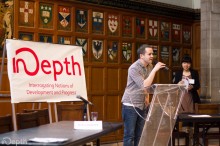On November 28, 2012, students and faculty gathered at the Asian Institute at the Munk School of Global Affairs to meet with Rajat M. Nag, the Managing Director General of the Asian Development Bank (ADB). The ADB, which was founded in 1966 and closely modeled on the World Bank, is a regional lending organization with the stated aim of “improving people’s lives in Asia and the Pacific.”
Mr. Nag, who’s talk was entitled “Asia’s Challenges: Ensuring Inclusive and Green Growth,” spoke about the need for Asia’s policy makers to address issues of inequality and environmental degradation. He argued that failing to do so would inevitably lead to social, economic, and environmental instability.
However, the ADB and its policies have been the subject of much criticism over the years. In 2007, a United Nations Environment Programme (UNEP) report criticized one of the ADB’s flagship programs, the Greater Mekong Sub-region project (GMS), for the potentially irreversible ecological damage and social inequalities associated with it. The GMS, which was initiated by the ADB in 1992, facilitates projects such as the construction of transportation networks and resource extraction.
The report, titled “Greater Mekong Environmental Outlook 2007,”stated that although the region has seen rapid economic growth, “it has bypassed more than 70 percent of its rural population, many of whom are directly dependent on natural resources for livelihoods and incomes.” The report went on to state that “the GMS still lacks a strong, credible body with the mandate to develop and coordinate its responses to environmental challenges.”
When questioned about the report, Mr. Nag said that although he agreed with some of their findings, he felt some criticisms were unfair. He said there are often social and environmental consequences associated with economic development, but the ADB’s investments have been largely beneficial to people in the GMS.
In a Hindustan Times op-ed authored by Mr. Nag, he argued that the GMS program “was crucial in helping war-torn countries initiate an informal dialogue that has evolved into market-driven economic cooperation. It is concrete proof that sub-regional cooperation can benefit all participating countries, resulting in a stabilizing peace dividend.”
Others are not as optimistic as Nag. In “Bounding the Mekong: The Asian Development Bank, China and Thailand,” Jim Glassman argues that battlefields have been turned into “marketplace battlefields.” He sees Thailand and China as being the main beneficiaries of ADB promoted policies, while countries such as Laos, Cambodia, and Myanmar serve primarily as sources of cheap labour and raw materials.
Despite these ongoing debates and critiques of ADB policies, they do seem to have taken heed to calls for the promotion of more green and inclusive growth. In “Clean Energy Financing at Asian Development Bank,” Laurence Delina writes, “Recent trends in terms of ADB investment in clean energy have been promising.” However, Delina also cautions that “programmes addressing the three pronged issues of poverty, sustainable energy and climate change remain fragile” and that the financing of large profitable projects are still favoured.
Zac Prong is a second year student majoring in Contemporary Asian Studies and Social and Cultural Anthropology.
